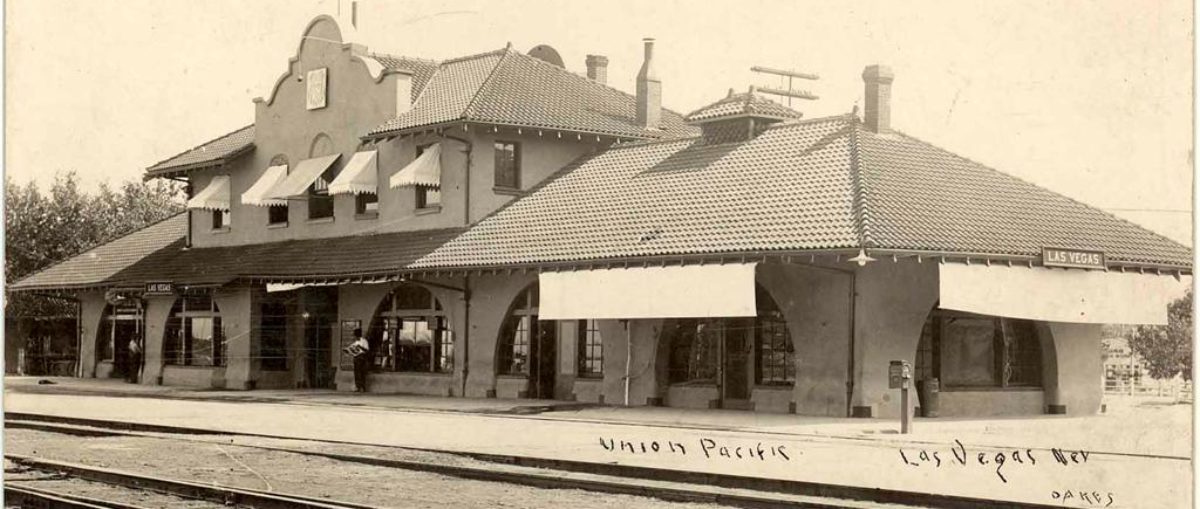Oh, them golden slippers
Oh, them golden slippers
Golden slippers I’m goin’ to wear
To walk the golden street
It stands proudly in the middle of Las Vegas Boulevard near the Neon Museum, but the Silver of the Slipper was a second precious metal choice by its owners. From Golden to Silver, the details follow.
The “Golden Slipper Saloon and Gambling Hall” opened on at 5 p.m. on the ground of the Last Frontier Hotel, on the Las Vegas strip, September 1, 1950.
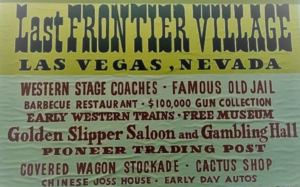
According to its owners the Golden Slipper, the design, a “combination vision of San Francisco’s ever famous Barbary Coast saloons and dance halls, along with the Union Pacific’s old time railroad,” will be an “innovation to Las Vegas.”[i]
Pointing out the “wood paneling on the walls though the entire structure are mahogany,”
William J. Moore and the other owners of the Golden Slipper said the “idea” for the Barbary Coast design came in 1945. [ii]
The owners added in their September 1, 1950 announcement, it was “just about five years to a day from the time the first models” concept were created.
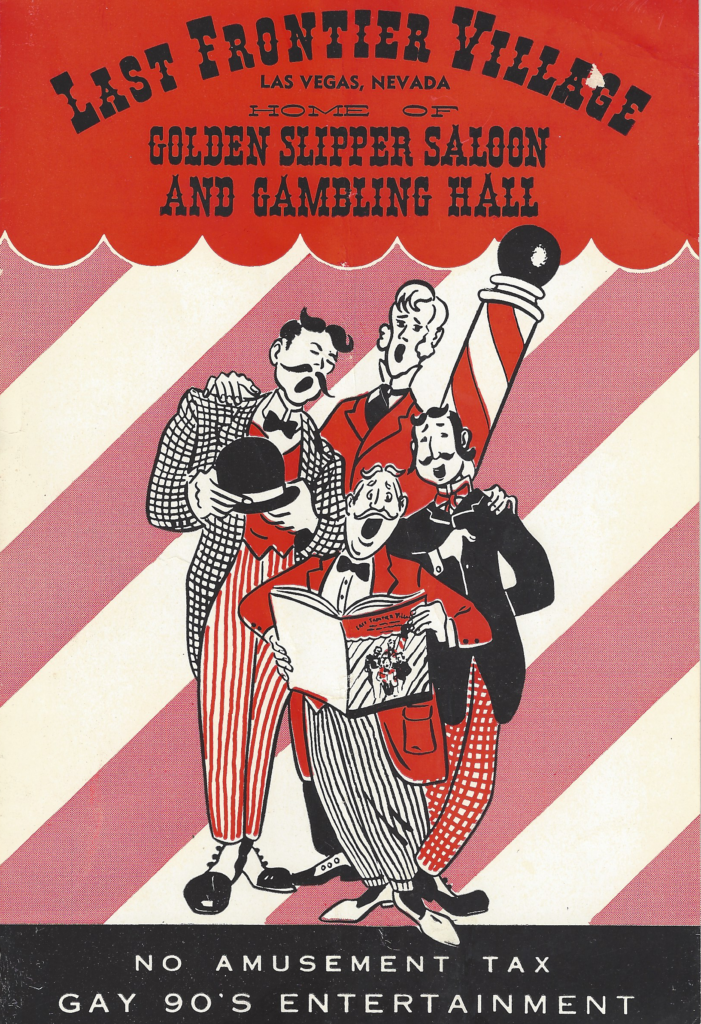
Bill Willard, at the time an entertainment columnist on the noted the similarity to another Las Vegas resort; “The Golden Slipper looks from the start as though it would be another bonanza like the famed Golden Nugget downtown. Based on a similar idea, the Gay 90s theme.”[iii]

Both Las Vegas newspapers, the Las Vegas Sun, September 2, 1950, and the Las Vegas Review-Journal, September 3, 1950, produced special sections for the opening of the Golden Slipper. The sections featured press releases from the club as well as advertisements from companies provided the work and building supplies for the construction of the resort, including the restaurant.

The major resorts on the Las Vegas strip also placed “welcome” announcements for the Golden Slipper. But only one downtown club, the Westerner took out a congratulatory advertisement.
The lack of enthusiasm from the downtown clubs was due in large part to the buzz that the Golden Nugget owners were upset.
Willard was not the only one who noted the similarity of the themes. The owners of the “Golden Nugget Gambling Hall, Saloon and Restaurant,” quickly contacted their attorney Art Ham Jr. who also owned a piece of the downtown casino.
The main force behind the idea, the construction and operations of the Golden Nugget was Guy McAfee.
McAfee, in a previous life was a Captain in the Los Angeles Police Departments’ vice squad. He came to the conclusion there were more financial opportunities in vice, gambling and the sale of liquor during prohibition.
By 1938, following local grand jury probes of his activities and the involvement of the U.S. Justice Department, McAfee moved from southern California to southern Nevada.
With his ‘colorful’ background McAfee clearly saw the opportunities in Las Vegas. After trying out several items, including renting buildings from a Las Vegas City Commissioner, McAfee built the Golden Nugget Saloon and Gambling Hall.
And, before it became the ‘strip’ McAfee saw the potential of resorts just across the county line on U.S. 91.
The Golden Nugget, which opened four years before the Golden Slipper, was being marketed as “a place of mahogany bars, crystal chandeliers, with genuine hospitality and old-time gaiety of the Barbary Coast and the Virginia City.”[iv]
At the same time the Last Frontier owners were putting up the Golden Slipper and the Frontier Village, a major expansion of the Nugget was underway.
And, McAfee was once again “personally supervising all details from start of the project to completion.”[v]
The “new parlor” on the Fremont Side of the Nugget, according to its owners “carries out the theme of the Golden Nugget vividly recalling the days of the historic ‘Barbary coast.” [vi]
McAfee also had a private reason, and a hidden agenda. When he moved to Las Vegas in 1939 he bought the Pair-O-Dice club. He quickly sold the club and the land to the buildings of the Last Frontier Hotel and Casino. In fact the designers, kept the Pair-O-Dice and built the Last Frontier resort around the old building. McAfee moved his investment funds to Fremont Street, later realizing the strip was the future.
This photograph, courtesy of UCLA shows McAfee in front of the Pair-O-Dice.
(Found a great article on McAfee at https://jhgraham.com/2016/09/20/guy-mcafee-1888-1960/ )
Maybe it was the name “Golden Slipper Saloon and Gambling Hall,” or that the concept was an “innovation” the owners had a year before the Golden Nugget opened but the Golden Nugget owners were more than upset, they said they were will to challenge the slipper in court.
Moore said at the time of the opening he received a call from Las Vegas Art Ham Jr. who he said was a “major stockholder” in the Golden Nugget. [viii]
Moore said Ham told him they were “infringing on the name of the Golden Nugget by our Golden Slipper.” [ix]
In addition to the name, Ham complained about the design of the Golden Slipper building was also too close that of their Golden Nugget, as well as what the Nugget was doing was “similar in the type of establishments that we were operating.” [x]
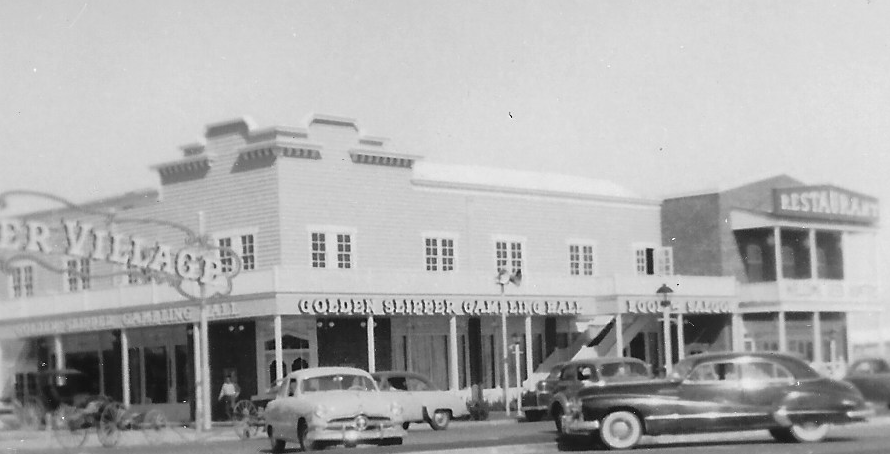
Moore said the Nugget attorney demanded the Last Frontier resort owners dropped the name Golden Slipper, and that if they didn’t “he would sue us claiming that we were infringing on the Golden Nugget” adding he “felt we were subject to considerable damages.” [xi]
Moore said with “all of our advertising, menus, matches so forth” had already been printed for the opening. [xii]
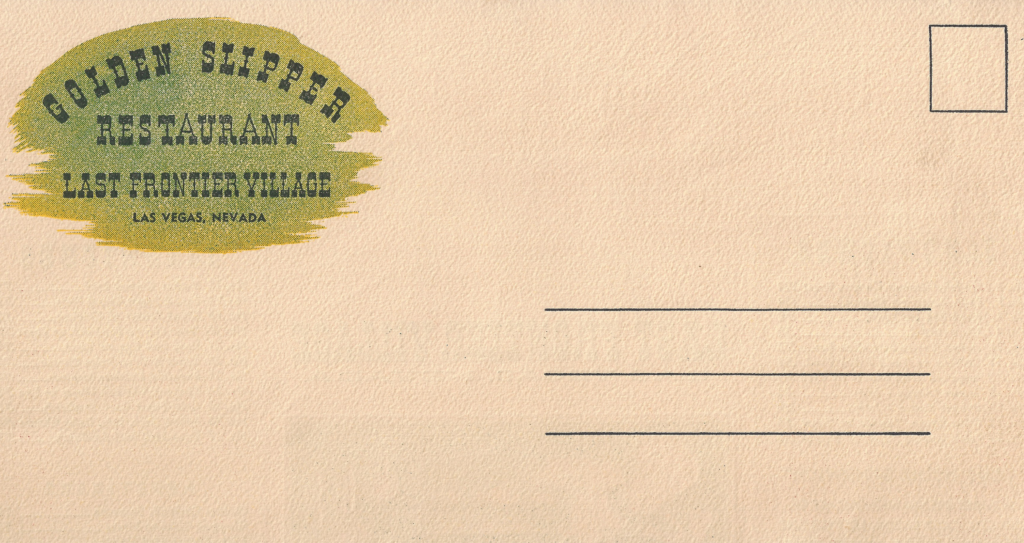
Bill Willard, a Las Vegas newspaper columnist at the time, would later write, McAfee “objected to anything golden other than his casino.”[xiii]
Talking with the other owners and their attorney, Moore said the group “felt that we were on thin ground, and we felt that we better change the name.”
Both sides talked and deal was worked out and the Golden did not become Silver until Mid-December of 1950.
While the staff was able to use up most of the Golden Slipper items, including the post cards, Moore said “It cost us somewhere in the neighborhood of $50,000 to reprint all the various advertising menus and so forth.”
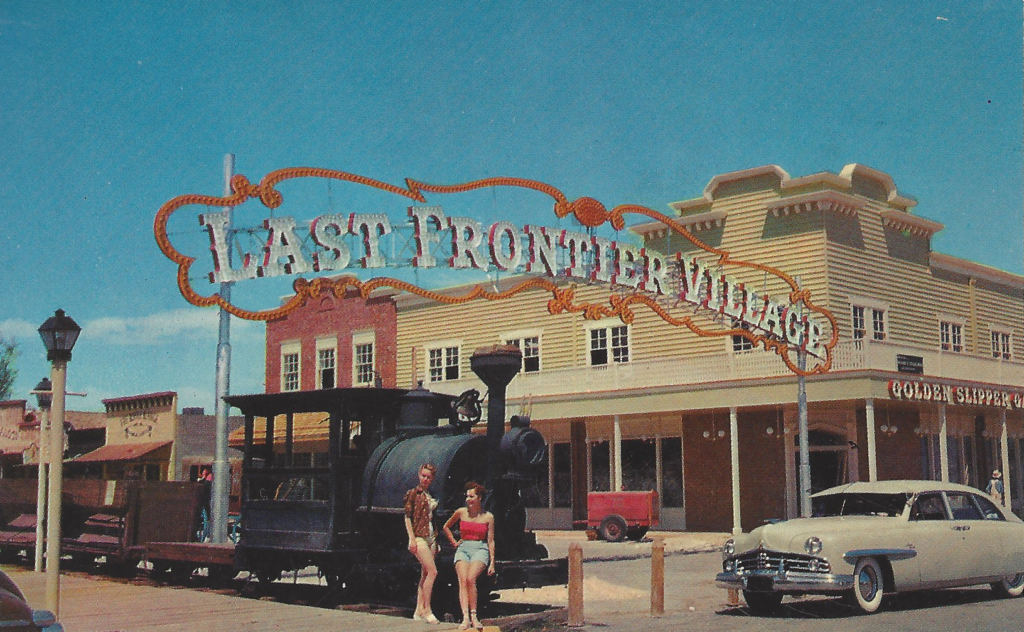
One of Moore’s Post Cards of the Golden Slipper.

A Golden Slipper Restaurant Menu given away as souvenirs.
Moore said after agreeing to change the name, his next step was a new name.
Wanting to keep the slipper concept, he said he went after resort on the Boulder Highway.
In April of 1946, the “newly remodeled Silver Slipper Club” had its “Grand Opening,” featuring an “All-star show,” led by “Doc Starr, Popular signer of popular songs,” and “Carolie Carron, clever English comedienne” with “The Rhythm Rascals.”[xiv]
The Silver Slipper Club was located on the Boulder Highway.
Moore said “we contacted the women who owned the bar, and made a deal to buy the name Sliver Slipper.”
Moore said they paid her to “discontinue the use” of Silver Slipper and we “bought her new signs changing the name.”
As part of the opening celebration Moore said they held a Cinderella like slipper event.
The contest looking for “The Golden Slipper Girl” required the winner not only to fit a golden slipper, the girl “whose figure most nearly compares to the sealed measurements being held in the Mayor’s office.”
The secret measurements turned out to be the same as the ones used by the Miss American committee in Atlantic City.”[xv]
As for the slipper, Moore said he went to a local shoe store and bought a slipper for “a rather small foot.” [xvi]
When the winner was determined it turned out to be the wife of one of the employees. [xvii]
Moore said, “later, we picked up one of her slippers and had it gold plated, and then later sliver plated when we changed the name from the Golden Slipper to the Silver Slipper.” [xviii]
Moore said he gave the gold plated slipper to the UNLV library. [xix] (Need to follow up and see if UNLV still has the gold and silver plated slipper.)
As the day for the change of names got closer, some confusion was apparent. In early December advertisements for both the Golden and Silver Slipper restaurants ran at the same time.
On December 6, on page 6, the Las Vegas Evening Review-Journal ran a column of advertisements under the heading “Dining Guide.” Thirteen small display advertisements for restaurants were listed. At the bottom, the just added “Silver Slipper Restaurant Featuring Hickory Barbecue Last Frontier Village.”
On page 7 of the same issue, newspaper readers found as display advertisement prominently displayed for the “Golden Slipper Restaurant, Hickory Barbecue, and Last Frontier Village.”
That was the last time the Golden Slipper advertisement ran in the newspaper.
Changing the name from golden to silver apparently was not enough for the Golden Nugget owners.
In July of 1951, Moore began negotiating McAfee to sell the Last Frontier and the Silver Slipper.
With approval from the state of Nevada Moore finalized the sale of the Last Frontier and the Silver Slipper, on the night of August 23, 1951.
McAfee and his partners took over active ownership at 11 a.m. on the morning of August 24, 1951.
P.S. Several decades later, in 1988, the Silver Slipper was moved and the building torn down.
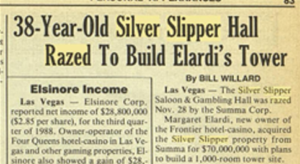 Columnist Willard wrote the obit for Variety on page 83, November 30, 1988.
Columnist Willard wrote the obit for Variety on page 83, November 30, 1988.
[i] “Golden Slipper Saloon, Casino Brings Memories of Early West to las Vegas,” September 3, 1950, Las Vegas Review-Journal, special section, page one.
[ii] Golden Nugget Postcard, “Night View of The Golden Nugget,” 1946 Associated Litho, Des Moines, Iowa, card 16AT181, message side of post card.
[iii] “Talk of the Town,” by Bill Willard, September 1, 1950, Las Vegas Sun, Page four.
[iv] Golden Nugget Postcard, “Night View of The Golden Nugget,” 1946 Associated Litho, Des Moines, Iowa, card 16AT181, message side of post card.
[v] “Golden Nugget Opens New Fremont Street Gaming Row Addition,” October 19, 1950, Las Vegs Sun, page one.
[vi] “Golden Nugget Opens New Fremont Street Gaming Row Addition,” October 19, 1950, Las Vegs Sun, page one.
[vii] “Golden Nugget Opens New Fremont Street Gaming Row Addition,” October 19, 1950, Las Vegs Sun, page one and two..
[viii] “An Interview with William J. Moore,” conducted by Elizabeth Nelson Patrick, August 29, 1981, Oral History Program, University of Nevada Reno Library C 1985, page 35.
[ix] “An Interview with William J. Moore,” conducted by Elizabeth Nelson Patrick, August 29, 1981, Oral History Program, University of Nevada Reno Library C 1985, page 35.
[x] “An Interview with William J. Moore,” conducted by Elizabeth Nelson Patrick, August 29, 1981, Oral History Program, University of Nevada Reno Library C 1985, page 35.
[xi] “An Interview with William J. Moore,” conducted by Elizabeth Nelson Patrick, August 29, 1981, Oral History Program, University of Nevada Reno Library C 1985, page 35.
[xii] “An Interview with William J. Moore,” conducted by Elizabeth Nelson Patrick, August 29, 1981, Oral History Program, University of Nevada Reno Library C 1985, page 34.
[xiii] “38-year-old Silver Slipper Hall razed to Build Elardi’s Tower,” by Bill Willard, November 30th, 1988, Varie ty, Page 83.
[xiv] “Silver Slipper Club,” display advertisement, April 27, 1946, Las Vegas Review-Journal, page 6.
[xv] “Golden Slipper Girl,” photograph caption, October 30, 1950, Las Vegas Review-Journal, page two.
[xvi] “An Interview with William J. Moore,” conducted by Elizabeth Nelson Patrick, August 29, 1981, Oral History Program, University of Nevada Reno Library C 1985, page 36.
[xvii] “An Interview with William J. Moore,” conducted by Elizabeth Nelson Patrick, August 29, 1981, Oral History Program, University of Nevada Reno Library C 1985, page 36.
[xviii] “An Interview with William J. Moore,” conducted by Elizabeth Nelson Patrick, August 29, 1981, Oral History Program, University of Nevada Reno Library C 1985, page 36.
[xix] “An Interview with William J. Moore,” conducted by Elizabeth Nelson Patrick, August 29, 1981, Oral History Program, University of Nevada Reno Library C 1985, page 36.
